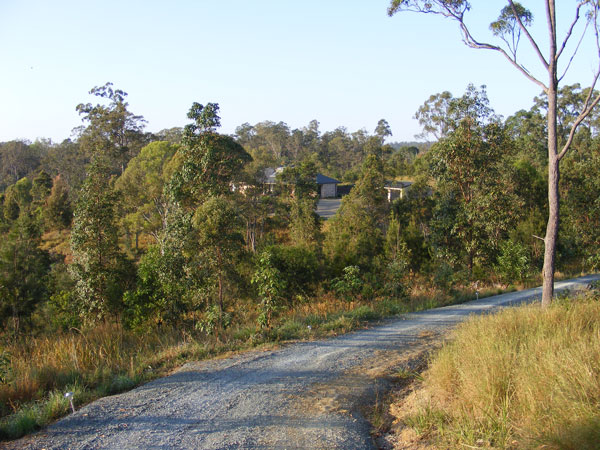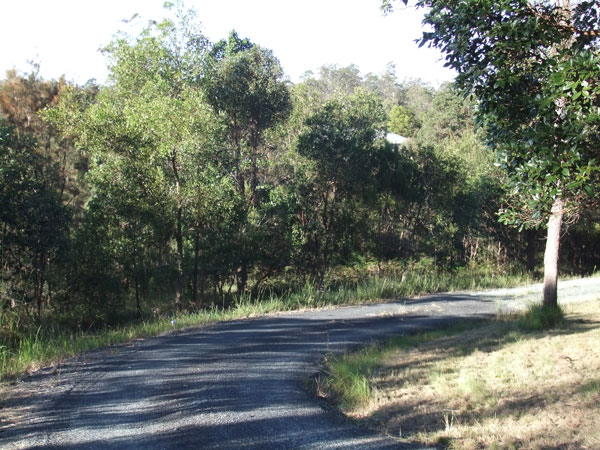It was with great excitement that we purchased our 5 acre block at Ocean View, Mt Mee in early 2004. At the time of purchase we were living in Emerald, Central Queensland. Our intentions when buying the block were always to build a house, establish a veggie patch and orchard and to regenerate as much bush as possible. However, as our commitments at the time were in Emerald, none of this occurred quickly. But as we shall see – this was a good thing.
Our block is located within an estate of other mostly 3–5 acre blocks. It is roughly rectangular in size, with the smallest width of the rectangle adjoining the road. It is undulating with a fairly steep, but short, drop at the front. It consists of a dam of approximately 900m2, fed by overland flow that runs in from the top left hand corner. At the bottom of the block, seasonal overland flow occurs, with the water making its way to the Caboolture River.
When we purchased the land, it had recently been slashed, however a very thick strip of native bush still existed along the overland flow course that fed our dam. Some other scattered semi-mature trees were present as were some small saplings and there was extensive evidence of native grasses peeking through.
The block was left to its own devices until early 2005 when we began to build. Inevitably a couple of the bigger trees needed to be removed and an access road and driveway was established. While the roadway did cause some inevitable disturbance it also helped minimise it as trucks stuck to the roadways and left the rest of the block untouched.
When we finally moved in approximately two years after purchase, we were keen to get started regenerating; however it seemed that not attending to the block for some time had already proved a great benefit.
We noticed that during the time left unattended, nature had already started to take its course without interference from impatient land owners. While the block had been slashed shortly before purchase it appeared we still had enough trees and grasses to provide seed to begin the process of regeneration without the need to plant.
Good rainfall at the time of purchase and the fact that there were no neighbours to complain about regrowth, enabled us to get quick growth without slashing. This helped us immensely. We noted that a variety of native grasses had grown and many native saplings were well established. Some weeds were evident but not too many. Ecological succession had begun.
As block regeneration had begun we turned our attention to our ‘home improvements’. We planted the planned vegie patch and orchard and also cleared around the house and along the driveway for fire protection. Having completed these additions we were now ready to look again towards regenerating the block and ways to conserve and promote a range of habitats in order to attract as great a variety of plants and wildlife as possible. After our ‘home improvements’ we were left with approximately three acres of the land to do this with. So what to do first?
Step 1
Visit from Land for Wildlife Officer.
As we were fairly ‘green’ to the field of regeneration and all things ‘bush’ it was rst important to identify what we had. Therefore step one was a visit from the local Land for Wildlife Officer who walked the block and identified the plants and weeds and habitat types that were present. Even at this early stage the Land for Wildlife Officer was impressed by the amount of native grasses, herbs and the variety of understory and shrub layer present. It appeared our ‘unplanned plan’ to let nature take its course had done the trick.
Step 2
Weed management.
Once we had identified the weeds, the next step was to work out what to do with them. The main weeds on our property were Groundsel, Billy Goat Weed, Lantana, Slash Pine and Mist Flower in the gully.
Our initial approach was to do a massive cut and paste blitz before the plants flowered and set seed. We did not want to spray as we did not want to risk poisoning other plants and had always intended to use as little herbicide as possible. So together we walked the bush, one cutting, one painting the raw stalk with roundup. This was our main approach for the first couple of years. Since the initial blitz we have used a couple of different approaches including hand pulling and cutting and mulching on steeper sites. Both have proved very effective and today very few weeds are present. However vigilance is the key.
Step 3
Develop a variety of habitat.
This included not only planting out areas such as around the dam but equally important was the house garden and driveway plantings. Lomandra was our choice for driveway edging. Not only did this help with erosion but a long row of lomandra looks great as well. To keep it looking good we cut it back once a year.
Around the dam we planted lomandra and paperbark tea-trees and in the dam, Woolly Frogmouth (Philydrum lanuginosum). For our house gardens we were guided by drought tolerance, erosion control, appearance and value to native fauna. Most of the plants we have chosen are natives however some such as gazanias are not.
In an attempt to develop a variety of habitats and in view of the fact that we have very few old, hollowed trees on our block we also applied for a Land for Wildlife grant to install several nesting boxes. Our application was successful and nesting boxes for a variety of animals are now scattered around the block. From observation we are certain some are regularly utilised.
“We noticed that during the time left unattended, nature had already started to take its course without interference from impatient land owners.”
Step 4
Monitoring and maintenance.
Seven years after we purchased the land we have achieved our aim of habitat variety and are reaping the benefits from the amount and variety of wildlife this attracts.
Before and after shots show just how much the canopy has thickened up and we now have a well developed understory, shrub layer and a strong variety of grasses and herbs. We continue to monitor, slash and remove weeds where required but as always, leave the rest alone. We are lucky that our neighbouring blocks have also chosen to regenerate and being the middle block we feel the benefits of this.


Property in June 2007 (left) and May 2011 (right) showing the amount of dense natural regeneration that has occurred.
Though our regeneration plan was simple we feel we are a great example of how you can achieve a lot by doing very little. At all times we have tried to work with nature and not against it. For example as a seed bank already existed on our block we have planted very little and where we did plant we observed what was growing successfully in other similar areas of the block and planted these species.
We’ve never read extensively to work out what to do but rather have been guided through our observations and common sense. We have kept our approach simple and been pragmatic during all stages. Patience is important with this approach but really seven years has not been a long time to wait for the benefits we have been awarded.
Kangaroo Grass (Themeda triandra)
Hickory Wattle (Acacia disparrima)
Coastal Banksia (Banksia integrifolia)
Grey Gum (Eucalyptus propinqua)
Soap Tree (Alphitonia excelsa)
Native Co ee (Breynia oblongifolia)
Cheese Tree (Glochidion ferdinandi)
Tape Vine (Stephania japonica)
Swamp Box (Lophostemon suaveolens)
Brush Box (Lophostemon confertus)
Geebung (Persoonia cornifloia)
Native Raspberry (Rubus sp.)
Lomatia (Lomatia silaifolia)
Willow Bottlebrush (Melaleuca saligna)
Coastal Paperbark (Melaleuca quinquenervia)
Black She-oak (Allocasuarina littoralis)
Prickly Broom Heath (Monotoca scoparia)
Hibbertia stricta
Lilliacee, swordsedge and lomandras.
Black Glossy Cockatoos
Red-necked Wallabies
Bandicoots
Cockatoos
Geckos
Snakes
King Parrots Pale-headed Rosellas
Lorikeets
Wood Ducks Quails
Fairy wrens

We are keen to seek assistance/ advice on how to best rehabilitate the riparian areas to the Creek that runs through our property .. in order to protect the threatened aquatic life as well as all other native species.
Hi Gail. The Land for Wildlife program provides exactly that type of advice and assistance but without knowing where your property is located, it is tricky to recommend who you should call. In South East Queensland, please contact your Local Government (Council). Our site provides links to Councils https://www.lfwseq.org.au/become-a-member/ and other parts of Australia where LFW is offered https://www.lfwseq.org.au/land-for-wildlife-reach/